 Newly available from Lubera Edibles are two hardy passion fruits: Cooltropics® Eia Popeia® and Cooltropic® Snowstar®. In the next few years, the Cooltropics® series will be expanded with many new varieties from the Lubera breeding programme. This is reason enough to ask Lubera breeder, Raphael Maier, for a presentation and classification of the new fruit variety for the northern garden. How exactly do hardy passion fruits work, how can they be produced and propagated and when is the ideal time to sell them? And finally: where exactly will the Cooltropics® passion fruits find their place in the range of edible plants?
Newly available from Lubera Edibles are two hardy passion fruits: Cooltropics® Eia Popeia® and Cooltropic® Snowstar®. In the next few years, the Cooltropics® series will be expanded with many new varieties from the Lubera breeding programme. This is reason enough to ask Lubera breeder, Raphael Maier, for a presentation and classification of the new fruit variety for the northern garden. How exactly do hardy passion fruits work, how can they be produced and propagated and when is the ideal time to sell them? And finally: where exactly will the Cooltropics® passion fruits find their place in the range of edible plants?
Origin and biology: the passion fruit
There are over 700 different Passiflora species worldwide, 90% of which are found on the American continent. The best known of these is Passiflora edulis, which comes from Brazil and Colombia and is the source of the well-known passion fruits found in supermarkets. However, apart from Passiflora edulis, there are at least 100 other Passiflora species that produce edible passion fruit.
A second Passiflora species is regularly sold as a conditionally hardy climbing plant: the blue passion flower Passiflora caerulea, which originates from Argentina. However, the winter hardiness of Passiflora caerulea is insufficient for widespread cultivation north of the Alps.
Passiflora incarnata, originally from the eastern United States, has a special position among the many passion flower species. It is distinguished by its absolute winter hardiness, willingness to bloom and tasty fruits. Long before Columbus' arrival, the Native Americans of North America were already eating the passion fruits of Passiflora incarnata and also cultivating the plant.
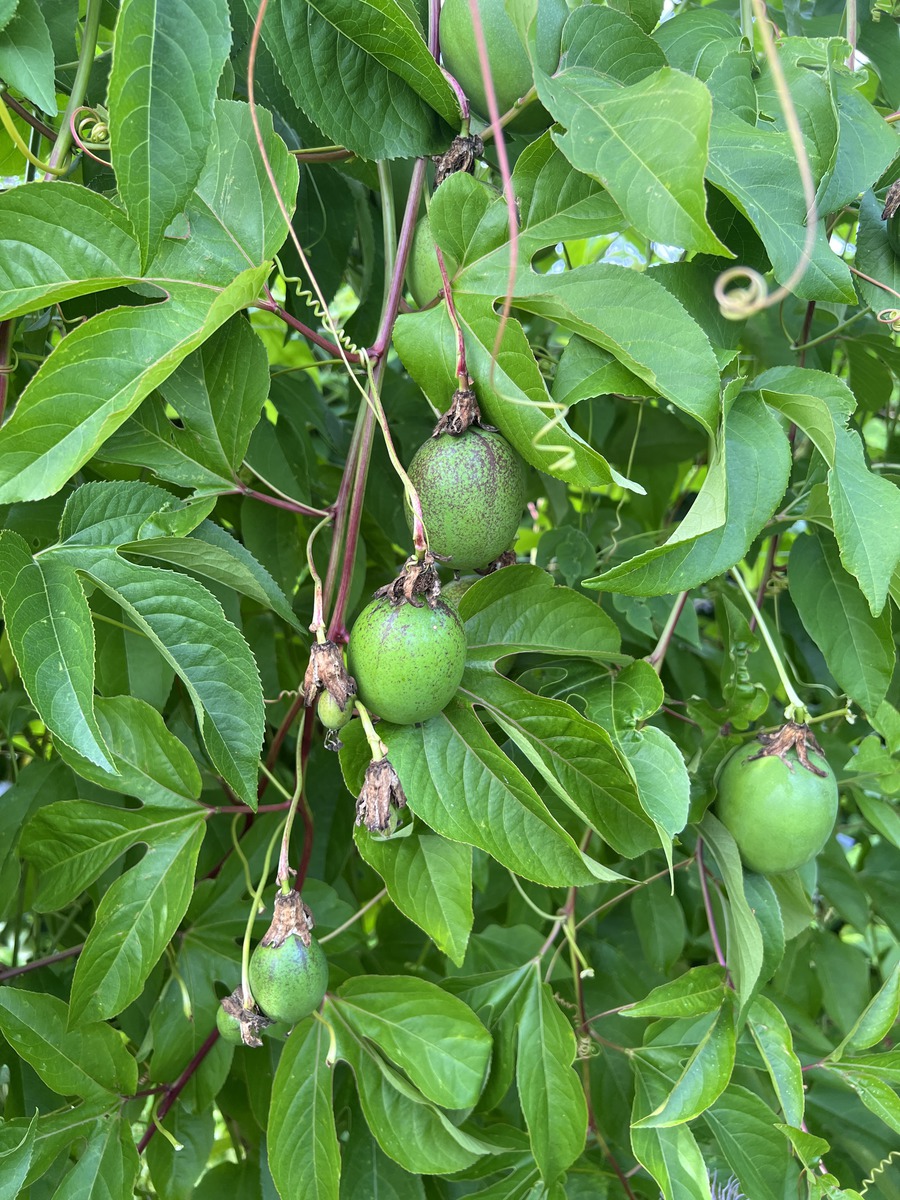
Picture: Fruits on Passiflora incarnata
Passiflora incarnata – the hardy passion fruit
Passiflora incarnata is a climbing plant that can grow 2 to 4 m high thanks to its leafy vines. This hardy passion flower has three-lobed leaves and finger-thick roots. The beautiful, large and exotic flowers appear under good conditions from the seventh leaf on each node. They give off a pleasant fragrance and are usually only open for one day, but are very numerous. The flower consists of a ring of five petals and five sepals. Above this is a broad, coloured corona. In the centre of the flower are the sexual organs. Passion flowers have a so-called androgynophore. The five male stamens with the pollen are at the bottom, the ovary is above them in the middle and the whole thing ends with the three pistils. The flowers attract numerous insects and are extremely popular with bumblebees and carpenter bees.
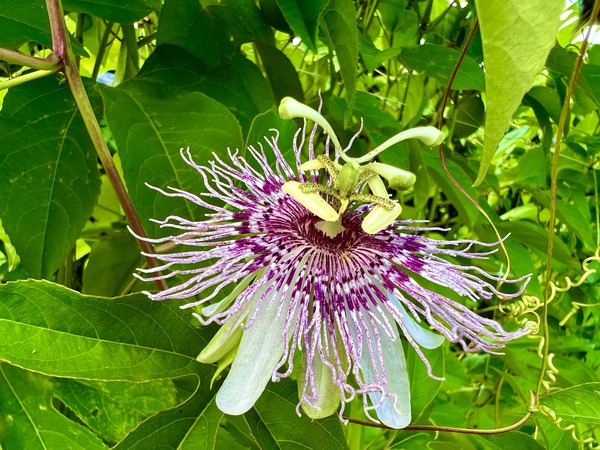
Picture: Close-up Passiflora incarnata
How hardy are hardy passion fruits?
When it comes to passion fruit, one immediately wonders how hardy these exotic climbers can be. The question is quite justified. The majority of the more than 700 Passiflora species cannot withstand frost. Passiflora incarnata, however, is an exception. Because of its North American origin (here it can be found as far north as Illinois and Pennsylvania), the plant can withstand -20°C without any problems. However, the climbing plant hides in the ground in the winter: Passiflora incarnata ultimately grows as a perennial. The shoots die back in late autumn and sprout again from the rootstock in the spring. Something similar is known from perennial clematis such as Clematis itegrifolia or also from hops.
Despite its good winter hardiness, a warm location is highly recommended. Passiflora incarnata is a sun worshipper and grows best and fastest at high temperatures. New shoots in the spring also depend on the outside temperature and often do not appear until mid to late May. If cultivated in a foil tunnel, greenhouse or next to a warm south-facing wall, the plant will start growing earlier and the fruits will also ripen better.
Slugs are often to blame for too late budding, as these little creatures like to eat the new shoots of Passiflora incarnata just as much as dahlias or lettuce plants.
The fertilisation conditions in Passiflora incarnata: this is how the passion fruits are produced
The passion flowers of Passiflora incarnata are andromonecious. This means that there are both male-only and hermaphrodite flowers. The ratio of male to hermaphrodite flowers changes during the season. At the beginning of the season, usually 2/3 of the flowers are hermaphrodite; towards the end it is only 1/3. Also, plants under stress usually produce more male flowers than hermaphrodite ones. The male flowers can be recognised by the fact that the pistils are bent strictly upwards. If the hermaphrodite flowers are suitably pollinated, small passion fruits form from the swelling ovary after a few days. These grow quite quickly to their final size within two weeks. However, depending on the weather and the variety, it takes another two to three months until the fruit ripens. This means that fruits that are formed after mid-August usually do not ripen. However, our varieties have been selected for early flowering and fruiting. Many fruits of Passiflora incarnata change their colour from a deep green to a light yellow-green towards maturity. They also often smell very pleasant as they ripen.
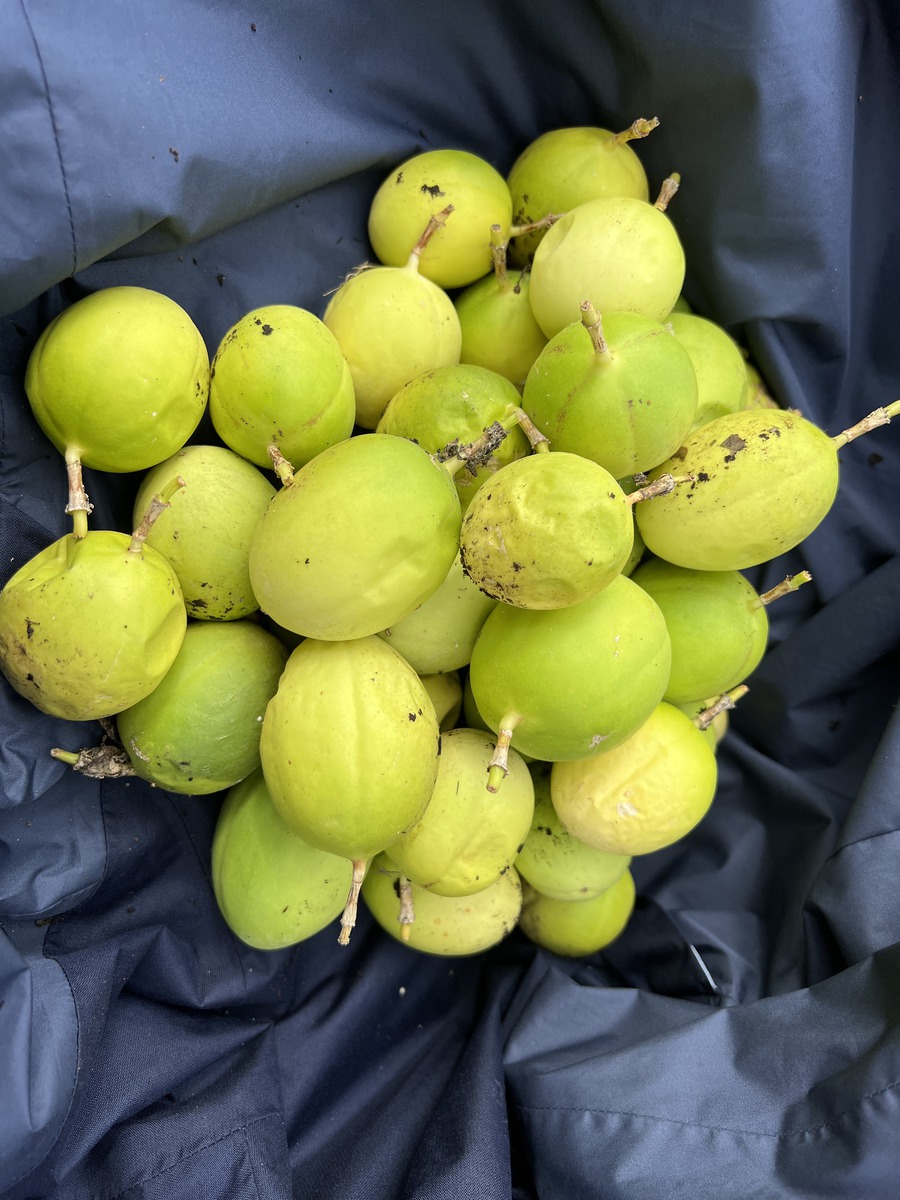
Picture: ripe fruits
Passion fruits are cross-pollinators
Passiflora incarnata can be pollinated almost exclusively by pollen from another variety. In the Lubera® breeding programme we are trying to remove this barrier and look for self-fertile varieties, but currently at least two varieties have to be planted to set fruit. Or you can put it another way: a Cooltropics® passion flower and also several plants of the same variety flower incessantly, but they do not set fruit. Fruits are only produced when two or more Cooltropics® varieties are planted together. By the way, the blue passion flower Passiflora caerulea can also serve excellently as a pollen donor. Its rich pollen is very well accepted. Bees and bumblebees can carry Passiflora pollen more than a kilometre. The best pollinator species, the violet carpenter bee Xylocopa violacea, can even fly up to 6 km. Nevertheless, a maximum planting distance of 10 m is preferable to guarantee a rich harvest.
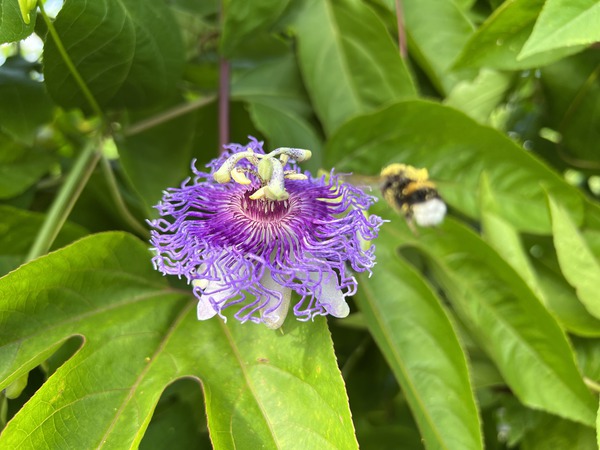
Picture: Bumblebee approaching
When are the fruits of the hardy passion flower ripe?
How do I know if the passion fruits are ripe? Quite simply: they fall off by themselves or can be easily detached under gentle pulling. Passiflora incarnata passion fruits taste best at this time of harvest. Although the fruits can also be stored in a cool place for two to three weeks, the acidity in the fruits fades and they become bland as the storage period progresses.
The taste of Cooltropics® passion fruit
What do the fruits of Passiflora incarnata taste like? If you compare the fruits of Passiflora incarnata with the fruits of typical passion fruits (Passiflora edulis) from the supermarket, it is like comparing apples with pears. Apples and pears are very similar in many ways, but you cannot compare the taste. So Passiflora incarnata also tastes clearly different from Passiflora edulis, but certainly not worse. The taste is an aromatic-exotic mixture of a juicy sweetness with a fine citrus-like acidity. Depending on the variety, degree of ripeness and location, the taste can vary significantly and the aroma can be reminiscent of strawberry or pineapple. In any case, it is a taste experience.
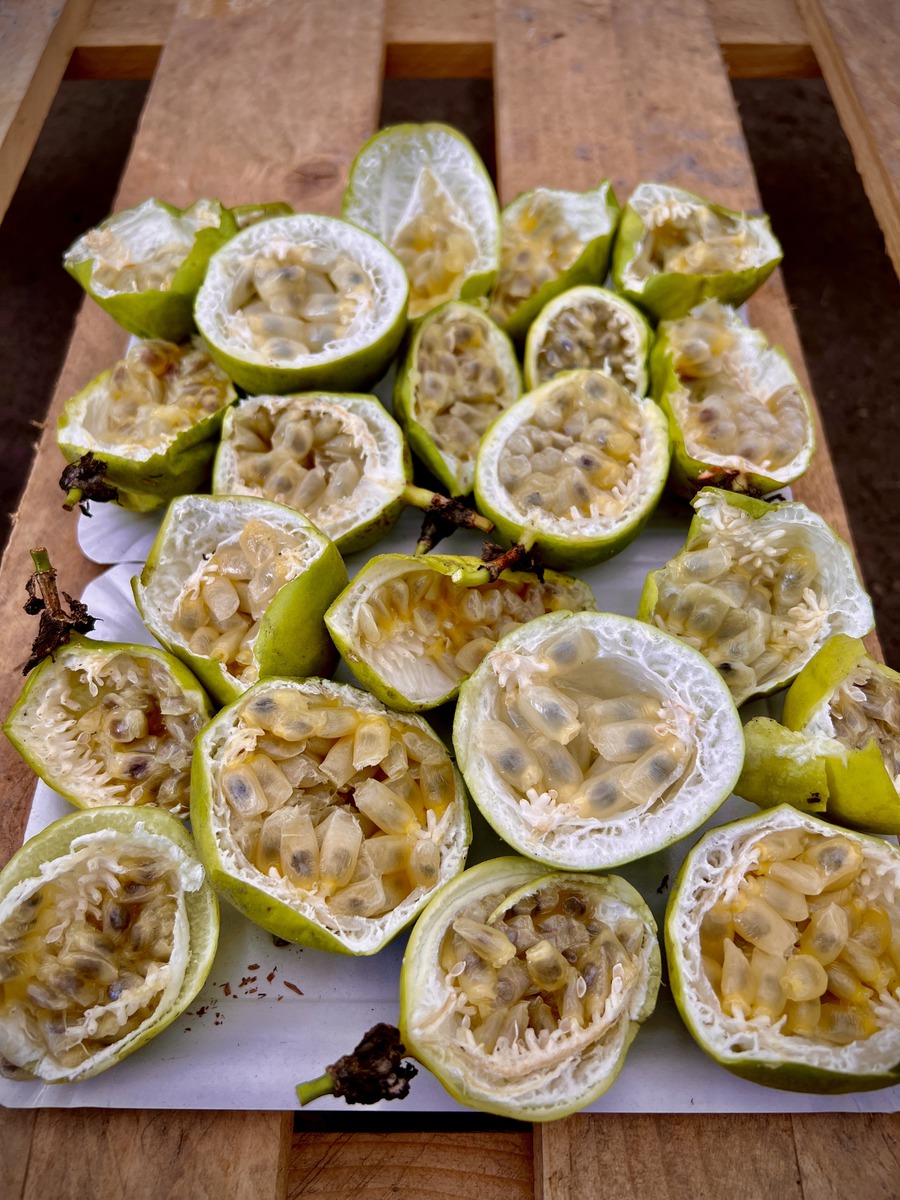
Picture: tasting of Passionfruits
Cultivation in nurseries or market gardens
Passiflora incarnata varieties and hybrids can be cultivated and sold in different ways. Basically, the plants are very easy to care for; they tolerate a wide pH range and also grow quickly with good fertilisation and watering.
Cultivation in a small pot together with high-quality fruit vegetables
One possibility is to cultivate the passion fruits similar to cucumber or pepper plants. Young plants are potted in February and March in a 10.5 cm or 12 cm pots and cultivated warm. The cultivation can be done in the same way as for fruit vegetables. The plants are then sold with the other heat-loving fruit vegetables at the end of April. The advantage of this is a relatively short cultivation period and simple cultivation management, as the plants can be fertilised and cultivated in the same way as other fruit vegetables. They can also be sold together in an assortment of unusual fruit plants such as Physalis or melon.
The disadvantages of this method are the lower sales prices and the fact that you sell plants at a time when you already have an extremely high workload. Also, the plants sold are still smaller and without flowers.
Cultivation in large pots (2 to 5 L) analogous to clematis
The second production option is to create a larger and higher priced product that can be produced and sold in a similar way to clematis. For this, Passiflora incarnata young plants are potted in larger 2 L to 5 L pots after the spring storm, i.e. only in June to July. The plant is cultivated outdoors, in a plastic tunnel or in a greenhouse during the summer and allowed to grow freely. Good fertilisation and watering should be ensured. However, the plant can be left to grow freely; staking or tying up the plants is not necessary, only a strong root system should be achieved. In late autumn / winter, the foliage is removed down to a 10 cm stem and the plants are put away and overwintered frost-free.
To get the plants out of their winter dormancy at the beginning of March and to stimulate the roots, the temperature should be raised to 25°C for 4-5 days. Often a few sunny days in a closed greenhouse are enough. Further growth can be controlled very well by the temperature. At 15°C, Passiflora incarnata hardly grows at all. At 25°C, on the other hand, it grows very quickly. At the end of March, the newly sprouting plants are cut. In April and May, the new shoots are then tied to the climbing frame or, as with clematis, twisted around the climbing frame and, if necessary, provided with picture labels. At the end of May, large plants with flowers and flower buds can then be sold together with other climbing plants such as clematis.
This cultivation method is particularly suitable for farms that already cultivate other climbing plants such as clematis in a similar way.
Cultivation in pots and in the garden
How does the customer cultivate the hardy passion fruit at home? Here, a fundamental distinction must be made between two different cultivation methods.

Picture: flower wall
Freely planted Passiflora incarnata in the soil
The easiest way to grow the hardy passion flower is to grow it in the soil. To do this, the potted plant should be planted in a well-draining, nutrient-rich soil in early summer. Basically, Passiflora incarnata is quite undemanding and survives both in a poor, sandy soil with pH 5 and in a heavy, clay soil with pH 7.5.
The location should be as sunny and warm as possible. Planting on a south-facing wall or on a sheltered small hill will help. A warm location is not necessarily required for winter hardiness, as this is also given at -20°C. Rather, a sunny location helps the plant to sprout quickly in the spring. It also allows the plant to flower quickly and abundantly and to ripen fruits in time before frost.
During the first summer, the passion fruit plant should be supplied with plenty of water and nutrients. The requirements are similar to those for tomatoes. Well supplied, a small young plant will quickly grow to a considerable size in one summer. The hardy passion flower also forms underground, horizontal root runners through which it reproduces. In our climate, however, they are hardly invasive.
The critical part of cultivation (and where most customer questions arise) is during the spring. In the winter, the above-ground part of Passiflora incarnata dies back completely. Only the roots survive. The plant hides from the frost in the soil. Late in spring, the plants sprout from the roots. Depending on the climate and location, this may not happen until the end of May or beginning of June, as an air temperature of about 25°C is necessary for this. The plant is therefore not dead if it has not yet sprouted at the beginning of May! A location next to a warm wall helps the plant to sprout.
The young shoots are also extremely popular with nocturnal slugs, so that early shoots are often eaten away before you even notice that the passion flower is sprouting. So patience, slug control and a warm location are the order of the day. With this combination, the plant comes back year after year without any problems and delights the gardener in the garden.
Cultivation in a pot
Passiflora incarnata can be grown wonderfully as a pot plant on a balcony or terrace. The larger the pot, the better. A 10 litre pot with a trellis is the minimum. The larger the pot, the easier and better the passion flower will grow. With regular watering and fertilising (e.g. liquid fertiliser for flowering plants once a week) the passion fruit plant grows, flowers and fruits without any problems.
The plant can remain on the terrace until November. For overwintering, either the pot can simply be moved into a cold garage or cellar. Here you should check every 1-2 months that the substrate does not dry out completely.
Alternatively, the pot can also be left outside. In this case, it should be pulled close to the house wall and protected with overwintering fleece or jute bags.
As a rule, potted plants sprout earlier than outdoor plants.
Diseases and pests
In general, the hardy passion fruit is a healthy and vigorous plant. Pests that can attack the plant are, apart from the already mentioned slugs, stink bugs and in dry weather also spider mites. Spider mites should always be kept an eye on, especially when growing the plant in a dry greenhouse. In rare cases, nematodes can also damage the roots outdoors.
Diseases are rarely tragic and usually only occur at the end of the season: these include mildew, and bacterial diseases.
In the plant variety breeding at Lubera® we also try to select for good disease resistance in order to achieve the easiest possible cultivation.
Time of sale and market
For which market are hardy passion fruits worthwhile? At the moment, our breeding is clearly aimed at the home garden market. The Cooltropics® passion fruits, along with the Pawpaw, are among the very few exotic and extraordinary-tasting fruit plants that can be grown and harvested in the north without any problems. Passion fruit from your own garden! This argument will trigger an irresistible buying appeal in many gardening enthusiasts.
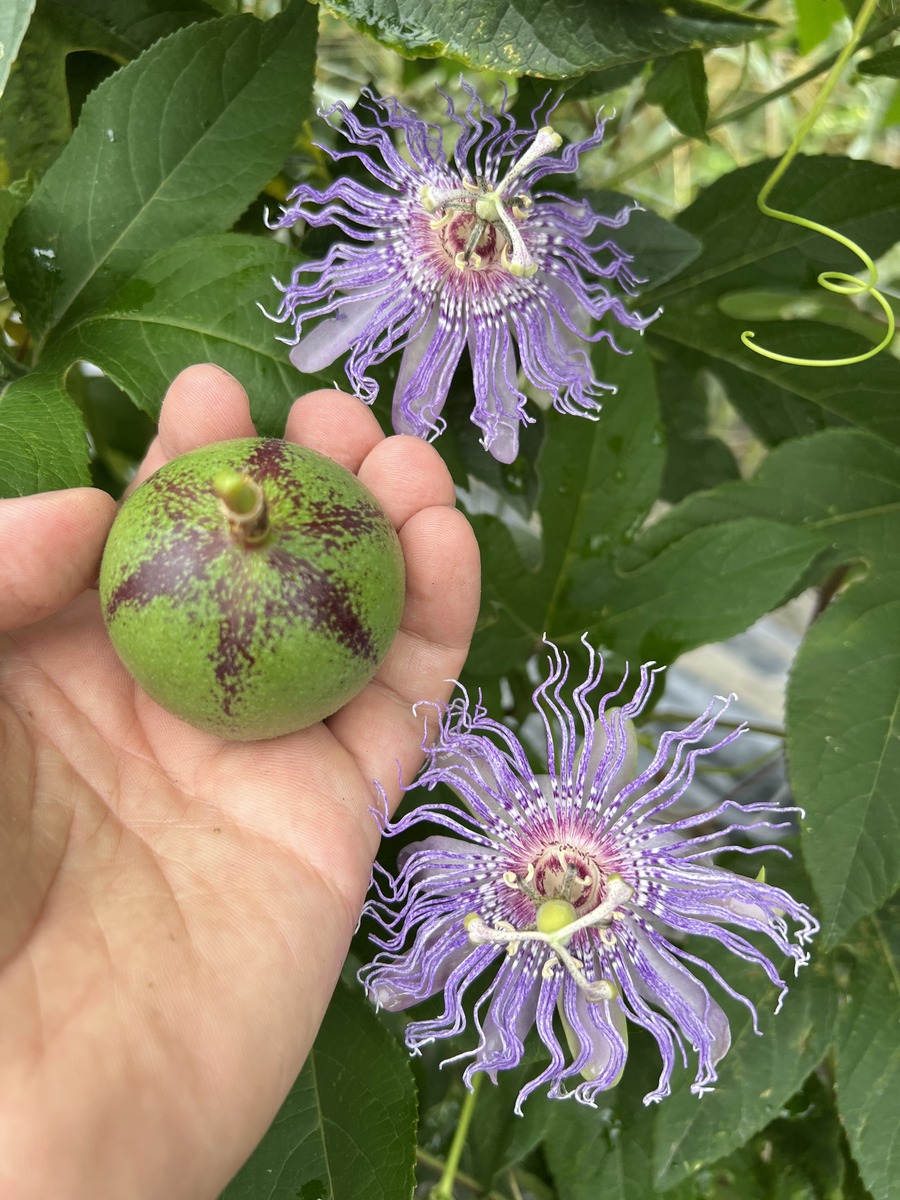
Picture: flowers and fruits
For the home garden market, the plant can in principle be sold from the end of April until September. The best time is probably May to June. Here, frosts are no longer to be expected (because the above-ground shoots are somewhat sensitive to frost, unlike the perennial root) and the hardy passion fruits have enough time to establish themselves in the garden. The plants can also be sold together with the rest of the climbing plant assortment.
A somewhat later sale from July to September has the advantage that plants with flowers and fruits can already be sold here. Such premium plants can obtain higher prices and lead to higher customer satisfaction.
Attention: not suitable for the classic soft fruit assortment in 1.5 to 3 L pots in March
In many garden centres and DIY stores, soft fruit is offered in February to April in 1 L to 3 L pots. Cooltropics® passion fruits are not suitable for this assortment. If they are sold forced at this time, they are at risk of frost because the above-ground shoots are sensitive to frost. If they are sold in winter dormancy, i.e. as a pot with roots and ultimately without above-ground organs, experience shows that consumers have too little patience, as the passion plants will not sprout until they are sufficiently warm in May or even not until June. This leads to unnecessary and premature complaints. We have also learnt that impatient gardeners then start digging for the roots and partly thereby endanger the plant even more and in the worst case also prevent the later sprouting...
Passion for passion fruit: arguments for the sale
Winter hardy passion fruits are a new product for the home garden market. But why include them in the assortment and what interest do customers have in buying these largely unknown climbing plants?
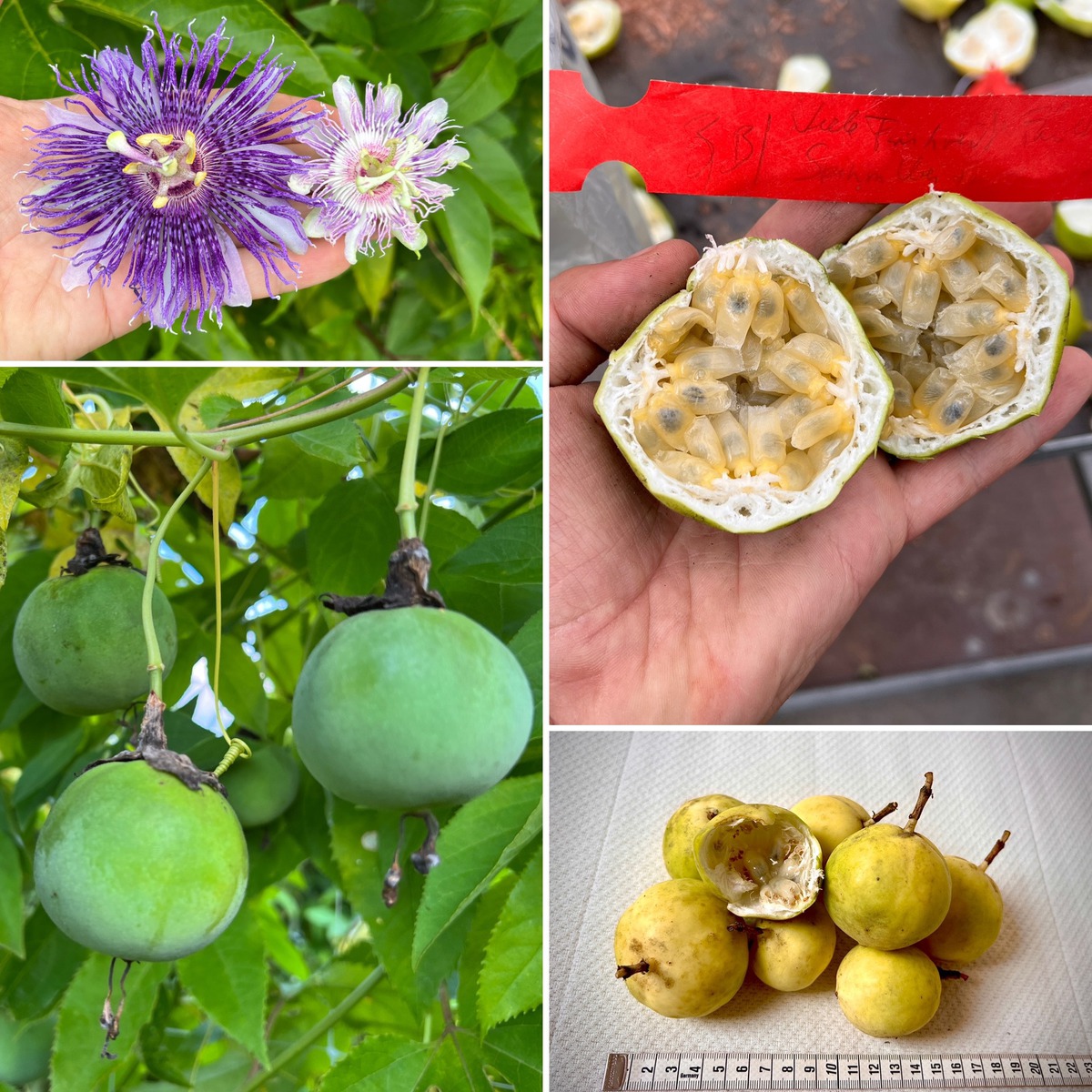
Picture: Passionfruit breeding
Exoticism for the northern garden: passion flowers are fascinating exotic climbers that immediately create a summer jungle feeling in your own garden. Their large, fragrant flowers are absolutely impressive and the glossy, three-lobed leaves of the climbers immediately transport you to tropical climes. And yet our Cooltropics® passion fruit plants are reliably hardy, since they function as perennials.
Use as a summer border plant and climber: Cooltropics® passion fruit, planted 50 to 100 cm apart on a climbing frame, forms an almost impenetrable exotic plant wall with irresistibly beautiful flowers until July. In the winter, however, when there is little light, they leave the space open...
Fruit and ornamental plant: Cooltropics® passion fruit plants perfectly combine usefulness and ornamental value. If you plant only one plant or several plants of the same variety, you can enjoy the flowers that keep appearing all summer until September. If you plant two or more varieties and thus ensure fertilisation, our varieties, which are also selected for fruit yield, fruit quality and early ripening, will produce a large number of fruits. In the first year you can expect a handful of fruits. From the second year onwards, under good growing conditions, 20 to 40 fruits per plant are not unusual.
Cultivation in a container or pot: container cultivation on a balcony or terrace is possible without any problems. Overwintering is very easy, as Passiflora incarnata does not need any light and hardly any water during the winter. It can simply be put in a dark, cold cellar and (almost) forgotten about until spring. Alternatively, it can even be overwintered on a terrace. In this case, however, the pot should be wrapped in fleece and moved to a sheltered place.
Cooltropics® passion flowers are the better and easier clematis: many hobby gardeners despair and fail time and again with clematis; repeatedly a clematis dies from wilt diseases or it cannot develop well in strongly sunny locations and if it is not shaded at the base. Cooltropics® passion flowers hardly know any of these problems. They grow, thrive and flower without any problems, except that they start a little later in the garden than the clematis, namely in May. The beauty of the flowers and their variety easily rival the clematis; they are quite simply a little garden wonder in their structure and with their striking sexual organs. We start in our assortment with one blue and one white variety, but in our breeding pipeline for the next years we have a variety of new colours and flower shapes.
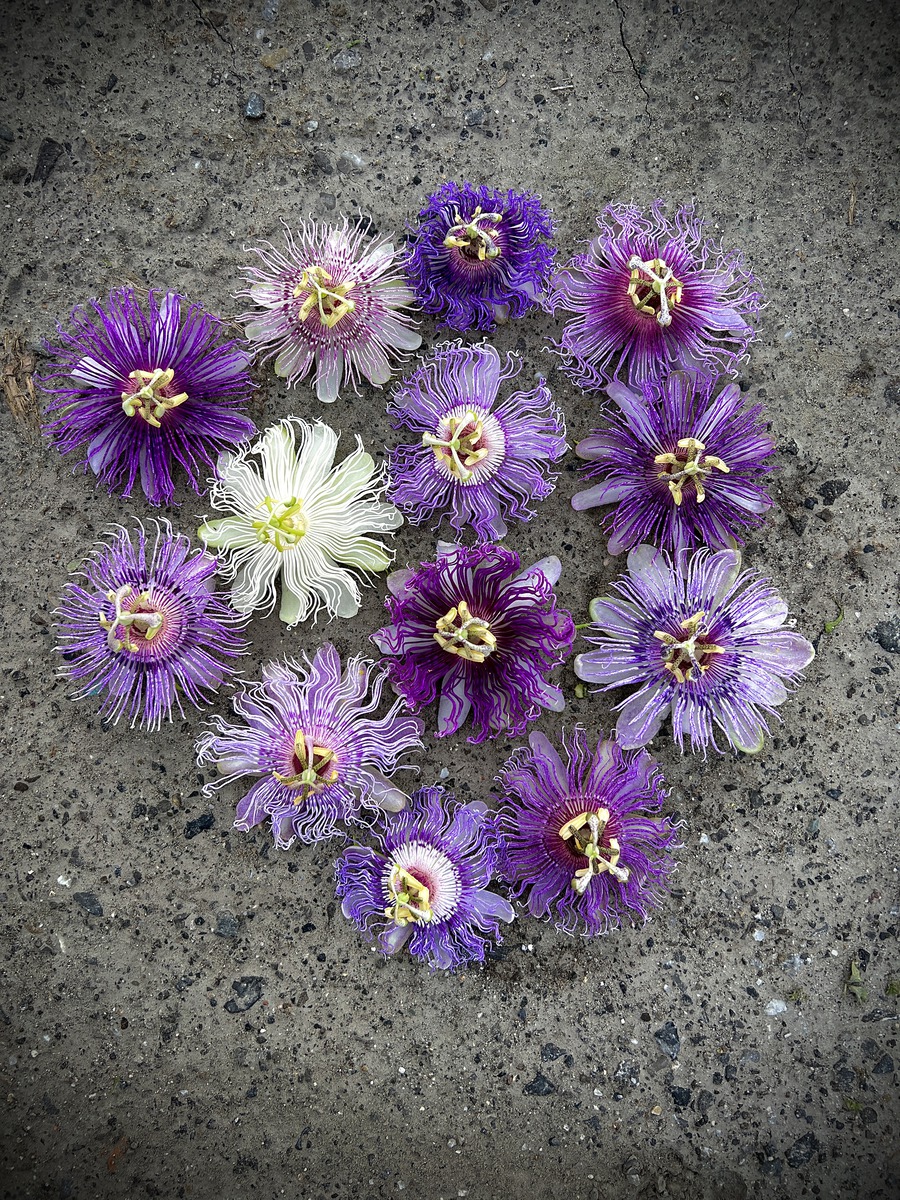
Picture: Passilora incarnata - flower colours
A winter hardy and ever-growing substitute for morning glory and black-eyed Susanne: many very beautiful and strong-growing summer climbing plants are only annuals and have to be replanted every year. The hardy Cooltropics® passion fruit plants grow comparably strong; they have larger and more complex flowers and overwinter easily as perennials, only to sprout again the next May and form an exotic, green wall full of beautiful flowers by July.
Beautiful and good, and healthy too: for the fruit assortment, Passiflora incarnata is an impressive addition. The plants bloom reliably from June onwards, bear countless fruits already in the first year and offer a never-before-seen tropical treat from your own garden. The native passion fruits are rich in vitamins A and C. Moreover, the young leaves can be eaten in salads and the leaves can be made into a sleep-inducing and calming tea.
Passion fruit breeding at Lubera
Lubera had already started selecting the first Passiflora incarnata variety Eia Popeia® 'Blue Pioneere' more than 10 years ago. Raphael Maier, who joined the Lubera® team, gave new impetus to the breeding. Already during his studies and before, he was intensively involved in Passiflora breeding and published a book on the breeding of hardy passion fruits.
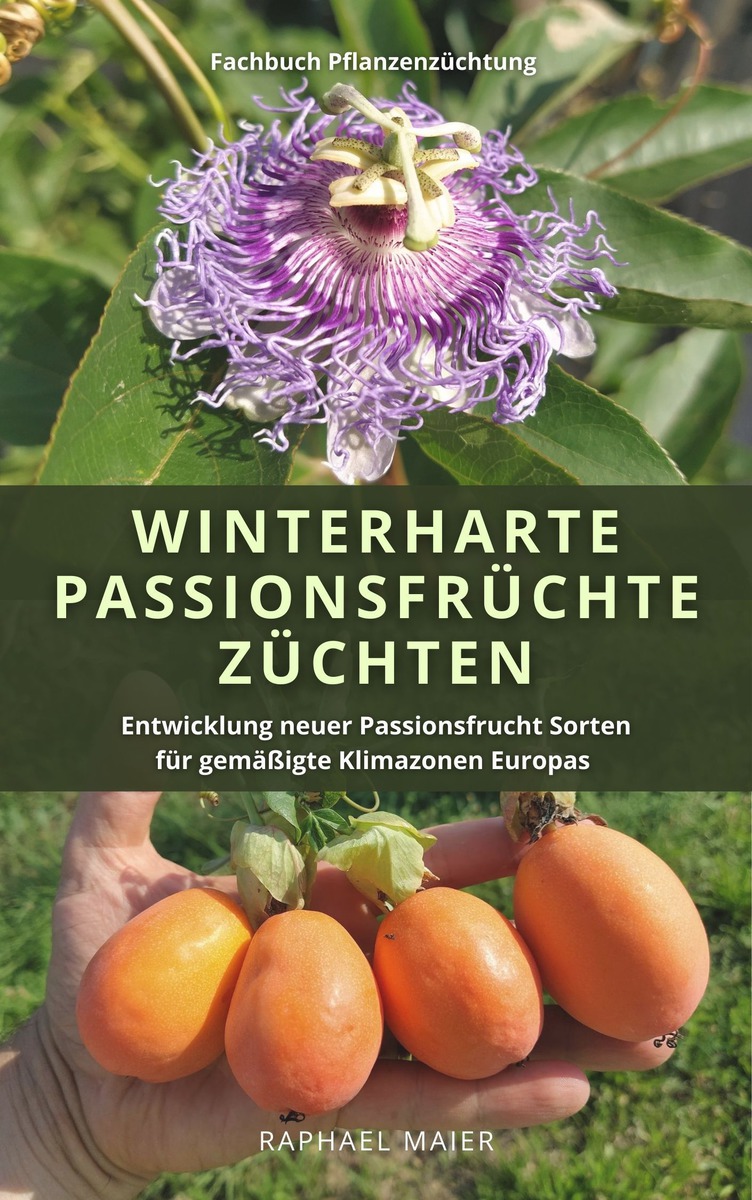
Picture: Book by Raphael Maier - 'Hardy Passion Fruit Breeding'.
This year we were able to test about 700 different genotypes of Passiflora incarnata and hybrids in the open field and make new crosses. The aim is to further domesticate the semi-wild Passiflora incarnata plants and to further improve the growth, flowering and fruiting characteristics by crossing with other Passiflora species.
Already this year we were able to select very promising cultivar candidates. These new hardy Passionflower varieties impress with very early fruit ripening, different flower colours (purple, red, pink, blue), extremely large fruits, double flowers per node, or other important characteristics.
The first varieties
At the moment we have two very good hardy passion fruit varieties in our assortment. Cooltropics® Eia Popeia® and Cooltropics® Snowstar®. Both are characterised by their easy cultivation, flowering and many well-filled, aromatic fruits. Cooltropics® Eia Popeia® captivates with its beautiful, purple flowers. Cooltropics® Snowstar®, on the other hand, produces a veritable round of pure white flowers.
Other varieties are already in the breeding pipeline and will complete the range in the coming years. We hope to bring three more varieties to the market in 2024-2025 and another three varieties one or two years later to complete the range.
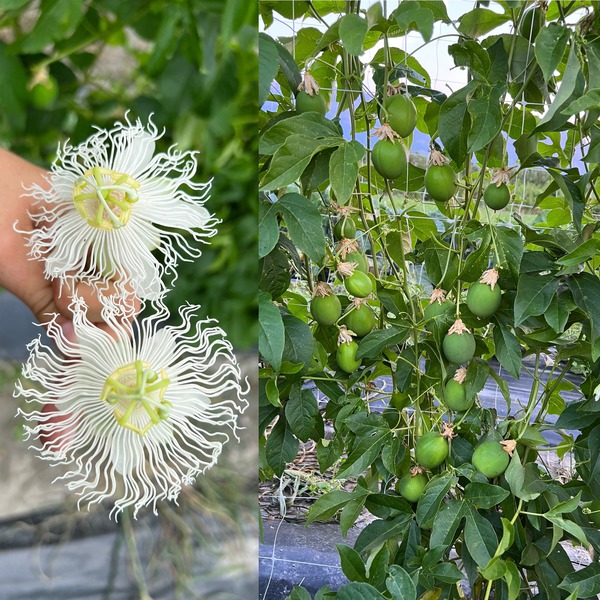
Picture: Cooltropics® Snowstar®
